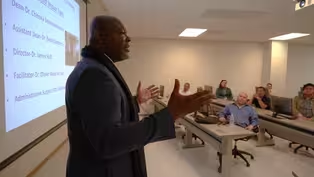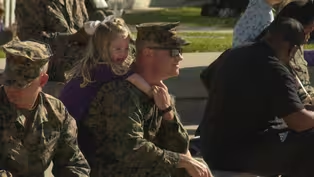Inside California Education
Universal Meals: The Impact of Free School Meals in California
Clip: Season 6 Episode 1 | 5m 12sVideo has Closed Captions
Take a look inside Sacramento’s Central Kitchen following the shift to free school meals for all.
Take a look inside Sacramento’s Central Kitchen following the shift to free school meals for all.
Problems playing video? | Closed Captioning Feedback
Problems playing video? | Closed Captioning Feedback
Inside California Education is a local public television program presented by KVIE
Funding for the Inside California Education series is made possible by the California Lottery, SchoolsFirst Federal Credit Union, Stuart Foundation, ScholarShare 529, and Foundation for the Los Angeles Community Colleges.
Inside California Education
Universal Meals: The Impact of Free School Meals in California
Clip: Season 6 Episode 1 | 5m 12sVideo has Closed Captions
Take a look inside Sacramento’s Central Kitchen following the shift to free school meals for all.
Problems playing video? | Closed Captioning Feedback
How to Watch Inside California Education
Inside California Education is available to stream on pbs.org and the free PBS App, available on iPhone, Apple TV, Android TV, Android smartphones, Amazon Fire TV, Amazon Fire Tablet, Roku, Samsung Smart TV, and Vizio.
Providing Support for PBS.org
Learn Moreabout PBS online sponsorship- Here at the Central Kitchen in Sacramento, they found innovative methods to serve up tasty meals, a lot of tasty meals.
- We serve 43,000 meals a day.
- Those meals include breakfast, lunch, afterschool snacks, and dinner for kids who stay late.
All meals are free and delivered with a simple intention.
- We believe every student, regardless of income, deserves a freshly prepared meal while at school.
Now everyone can come in for a lunch just like every student gets a book to study in the class.
- Central Kitchen provides meals for 80 schools in the Sacramento City Unified School District.
- We are the departments within the district, but funded separately, meaning we do not receive any funding from the district.
We get a small reimbursement from the state.
We receive a federal reimbursement for every breakfast, lunch, supper, and snack that we serve.
It covers the food and the labor, which are the most expensive costs, but it also covers the refrigerators.
We need the ovens, we need the repairs to them, the trucks, the vehicles to transport meals.
- It takes a lot of planning and advocacy to keep school meals healthy.
- We get to control how much salt we put into it, the sugars.
There's a lot of regulations in school lunch, but we also get to make the choices of which quality ingredients we're bringing in.
So having the ability to cook from scratch really gives us the ability to give our best to our students.
- Schools in Sacramento serve several entrees every day with a menu that rotates every one or two weeks.
Halfway through the school year, the menu shifts to new entrees.
- We'll change some things around so it's not stagnant throughout the year because kids do need fresh choices.
They need something new or else they'll lose interest.
- Free school meals started in 1946 with the National School Lunch Program, signed into law by Harry Truman.
Free school meals were provided to low income students, while other students paid because families had to disclose their household income to participate.
Experts say many students simply opted out.
It wasn't until the 2022-23 school year that California became the first state to implement a statewide universal meals program, breakfast and lunch for all school children regardless of household income.
Seven other states have followed suit with several more considering implementation.
- There isn't the stigma associated with school lunch anymore that has been around for decades.
There would be students that needed a meal, but they're with their more affluent friends and too embarrassed to go in and get a lunch, so they would just starve.
And I think that has vastly changed in the last couple years.
What we say in our program, if they're hungry, they can take as much fruits and vegetables as they want.
If they're taking it, it's because they're hungry.
- The central kitchen team keeps the menu interesting and healthy by adding fresh persimmon, mandarins, strawberries, and a different kind of apple every fall.
- We save money, we support local, we support California growers, which I think is important in an ag economy.
- The cafeteria team at McClatchy High School in Sacramento enjoys interacting with the students they feed - And the ladies and the gentleman working here, they say, “good morning, how your day?” and sometimes you can impact kids' life.
- That impact is rubbing off on student workers.
- The environment, you know, communicating well and just just helping out students.
That's what helps.
That's what I like about the job.
- I really like the sort of community that grows within the cafeteria.
It inspires me to be more of a hard worker.
- Thank you.
Have a good day.
- Crowd flow is important at McClatchy where lunch period is only 30 minutes.
Approximately half of the 2,500 students eat lunch from the cafeteria.
That's 1200 to 1300 kids in the lunch line in less than half an hour.
- High school's a long day.
Lots and lots of kids here are after school, so it's really important for them to get lunch.
- We're an educational system and we are trying to teach our kids how to eat better.
- National research indicates that students who participate in school meal programs have physical advantages over students who do not.
They have a higher intake of essential vitamins and minerals, are more likely to meet the daily recommended servings of fruits and vegetables, and have lower rates of obesity.
They also perform better academically and are more engaged in class.
Overhauling Math: A New Approach to an Old Subject
Video has Closed Captions
Clip: S6 Ep1 | 5m 25s | Visit a class in Val Verde Unified where teachers are helping students find new ways to learn math. (5m 25s)
Project Impact: Diversifying the Teacher Workforce
Video has Closed Captions
Clip: S6 Ep1 | 6m 6s | Project Impact is an effort by CSU San Bernardino and local schools to increase teachers of color. (6m 6s)
Purple Star Schools: Meeting the Needs of Military Families
Video has Closed Captions
Clip: S6 Ep1 | 5m 38s | Visit a school with a Purple Star designation for meeting the needs of military families. (5m 38s)
Providing Support for PBS.org
Learn Moreabout PBS online sponsorship
- News and Public Affairs

Top journalists deliver compelling original analysis of the hour's headlines.

- News and Public Affairs

FRONTLINE is investigative journalism that questions, explains and changes our world.












Support for PBS provided by:
Inside California Education is a local public television program presented by KVIE
Funding for the Inside California Education series is made possible by the California Lottery, SchoolsFirst Federal Credit Union, Stuart Foundation, ScholarShare 529, and Foundation for the Los Angeles Community Colleges.


